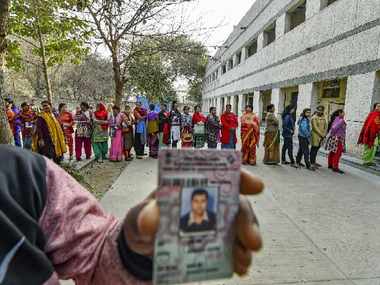The hotly-contested Delhi Assembly election resulted in a humiliating defeat for the Bharatiya Janata Party (BJP) and delivered a decisive win to the Aam Aadmi Party (AAP), which won 62 out of 70 seats. The results indicated that the communally polarising hate campaign that the BJP ran in the lead-up to the 8 February elections did not pay off . The overall vote share of the BJP stood roughly at 40 percent, in contrast to that of AAP’s — roughly 54 percent. The decline of the Indian National Congress was apparent with its vote share falling to roughly 5 percent. While there has been a lot of analyses on the performance of AAP, BJP and the Congress, other aspects like the level of competition, and aspects of candidates, such as the proportion and performance of incumbents, turncoats, women and first-time candidates, have received little to no attention. Some of these aspects can be analysed (at least partially) through data. Level of competition The average vote share of the winners in the election has been similar in the last few elections. In recent years, Delhi has voted in an astonishingly decisive manner — BJP for Lok Sabha elections and AAP for state Assembly — giving more than fifty percent votes to winners on an average. It is difficult to ignore how the average winning vote share has remained consistent despite the decisive victories of different parties in general and Assembly elections. It indicates that voters in Delhi are making a clear distinction between national and state election, with many of them voting irrespective of (or, devoid of) party loyalties.
Typically, such a high average winning vote share suggests a bipolar contest, which has been the case with Delhi for some time. With Congress’ vote share declining to roughly 5 percent, the bipolar nature of the contest between BJP and AAP further strengthened in the 2020 Assembly election.
New Elites?
Similarly, there have been some debates on giving tickets to candidates who have switched parties, or ’turncoats’. Commentators have made arguments for both sides — that turncoats are strategically beneficial, and that inducting turncoats is bad strategy — particularly in the context of defections from various Opposition parties to the BJP. However, again, the results of this election cannot be read as a validation for either of these arguments. The average vote share of turncoats and non-turncoats is very similar. The difference is not statistically significant (based on 95 percent confidence intervals), as statisticians would define it.
How did first-time candidates perform vis-à-vis candidates who have contested before? Another common debate in the discourse on politics is the ‘winnability’ (the probability of winning) of candidates as a function of their electoral experience. Parties — as well as commentators — often argue that giving tickets to those who have contested before is usually electorally more beneficial; that such candidates have more experience of campaigning and have some existing support base. Again, this election does not show any support for that argument either. The first-timers were almost as successful as those who have contested before: the difference between the average vote shares of the two groups is similar for the AAP and BJP. These figures can be explained in two ways. One interpretation is that it did not matter whether the candidate was a first-timer or had contested before. The other interpretation is that voters mainly voted along party lines, irrespective of the candidate. The difference in average vote share between the two categories is statistically significant for the Congress, but a lot should not be read into it; the overall vote share of the Congress is so low that a few popular candidates could have possibly skewed the balance.
Performance of female candidates One of the most popular ’explanations’ that is put forward to justify discrimination against women in the distribution of party tickets is, again, the ‘winnability’ argument: that women tend to perform poorer than men in elections and, therefore, parties are forced to make the pragmatic choice of choosing more men. The number of female candidates remained at a shameful low in this election as well: AAP, BJP, and INC gave only nine, six, and ten tickets to women respectively.
The problematic argument is even less convincing when one compares the performance of male and female candidates in this election. As the above graph shows, male and female candidates garnered an almost identical vote share. While the difference is ‘statistically significant’ for the Congress, it does not mean much as discussed above. It is, therefore, high time for the parties to stop shying away from distributing tickets to women and first-time candidates under the garb of ‘winnability’. These factors did not really mean much for winnability in the recent Delhi Assembly Election. While it is true that every election has its own peculiarities and conclusions from this election cannot be generalised, the larger point is that parties should seriously examine and scrutinise their ‘conventional wisdom’ that stops them from making some bold decisions. The author studies political science at Ashoka University and is a former research associate at Trivedi Centre for Political Data, Ashoka University
)